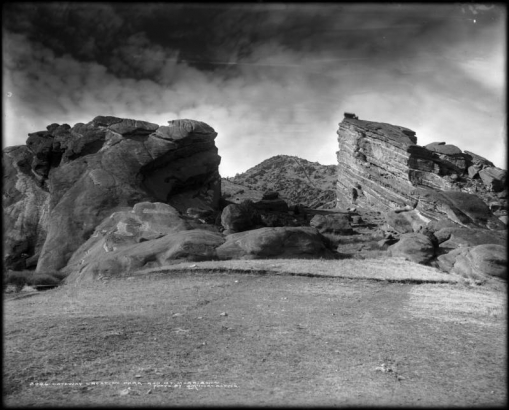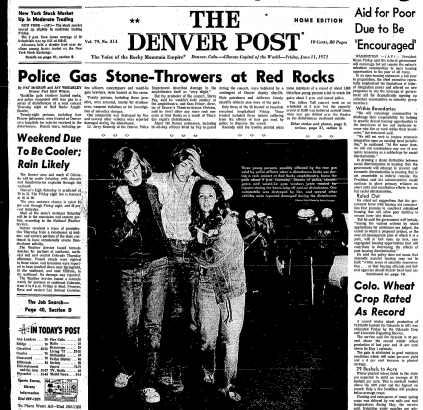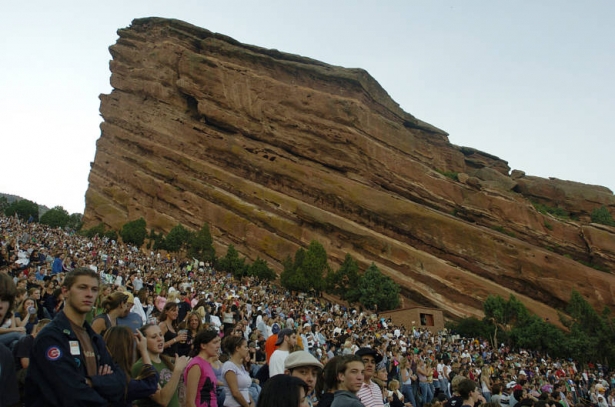On June 10, 1971, a large group of rock fans attempted to bum-rush the gates at Red Rocks Amphitheatre in an effort to see the band Jethro Tull.
In the aftermath of that event, the City of Denver imposed a ban on all "rock" shows at the venue, which didn't turn out quite how the City (mainly Mayor Bill McNichols) planned.
In fact, the city's rock ban actually wound up spurring on one of the most successful concert series of all time and catapulted Red Rocks into the realm of concert venue legend.
They Came from the Hills
If you're having trouble imagining how a Jethro Tull concert could turn into a riot, it might be a case of, "You had to be there to understand." In the late 1960s and early 1970s, plenty of young people felt as though music was an entity that shouldn't be commercialized. They were also not above using the full force of youth to rush into concerts, as was evidenced at the legendary Woodstock Festival.
That dynamic was in full effect at Red Rocks that night when thousands of fans who hadn't purchased tickets congregated in the hills surrounding Red Rocks to catch a free listen to the long sold-out show. The trouble began when the "hill people" decided that they should just go ahead and force their way into the amphitheater.
This did not go down well with the Denver Police Department, who have long held jurisdiction at Red Rocks on concert days.
What happened next was recounted by Chris Van Ness in the June 18, 1971, edition of the Los Angeles Free Press:
The police, feeling that it would be impossible to maintain security in any other way due to the rough terrain, began dropping tear gas out of helicopters which were flying a dangerously low watch over the crowds.
Rather than acting as a deterrent, the tear gas seemed to spur the now-rioters on to further acts of violence As more tear gas began to fill the amphitheater at an alarming rate, the gate-crashers and audience alike began to pick up bottles and rocks to use as ammunition against the police. One car was overturned and burned, and many people suffered injuries ranging from broken bones to gas inhalation.
Not only did the tear gas not quell the riots, it made its way to the stage at the base of the natural amphitheater. The scene could only be described as bedlam, and it had the potential to be a lot worse.
Welcome to World War 3
Backstage at Red Rocks, Barry Fey and the members of Jethro Tull were faced with a conundrum. They could cancel the show and send the paid audience straight into a riot, or they could play the show as planned.
To their everlasting credit, the members of Jethro Tull decided to go on with the show. Jethro Tull lead singer Ian Anderson took to the stage with guitar in hand and greeted the audience saying, "Welcome to World War Three!" And with a full-scale riot playing out in the hills surrounding them, and clouds of tear gas wafting onto the stage, Jethro Tull proceeded to play their full set.
The band's commitment to playing on earned them praise from both the Denver Police Department and Fey, who praised the band in the Los Angeles Free Press saying, "God bless those guys. They're the most professional group I've ever worked with. I don't know anybody else that would have stayed on through all that."
Rock 'n' Roll Aftermath
Reaction to the events at Red Rocks that night came swiftly from Denver Mayor Bill McNichols. The very next day, the mayor swiftly imposed a ban on all rock shows at Red Rocks saying:
As long as I'm mayor, this city is not going to be turned over to rock-throwing hoodlums. If they think they're going to be allowed to run free, attacking innocent people and police officers, they have another guess coming.
McNichols was hardly alone in his view on the future of rock 'n' roll at Red Rocks. Caught up in the moment, a clearly frustrated Fey said that he was done promoting rock shows at Red Rocks. In an interview with the Denver Post on June 11, he said, "If they (the rock artists) want to come into the (Denver) Coliseum (instead of Red Rocks), we'll do it. But most of them know of Red Rocks and wanted to play there."
Though Fey would ultimately change his tune regarding Red Rocks, Sam Feiner, the director of the city Theatres-Arenas Division, was firm in his stance that Red Rocks's time as a rock venue had, "definitely ended." To that end, upcoming shows by hard rock heroes Poco, Chicago, and Stephen Stills were canceled.
The Blame Game
In the aftermath of the riot, there was plenty of blame to go around. While the Denver Police were accused of overreacting to the situation by dropping tear gas, most of the blame was rightly aimed at the gate-crashing rioters.
At the Los Angeles Free Press, Van Ness said, "When it comes to placing blame for the events of last Thursday evening, it must rest with the kids who tried to crash the gate. But the rest of the chemistry is an all-too-familiar formula. The police reacted with fear and stupidity."
At the Rocky Mountain News, music critic Thomas MacCluskey pulled no punches in a column titled, "Rock Rowdies Ruin it for Everyone." MacCluskey pointed out that this was hardly the first time that Denver music fans had acted up.
He recalled that in August 1968, a riot had broken out at an Aretha Franklin show at Red Rocks after the legendary performer told the crowd that she would not be playing because she hadn't been paid. That resulted in a one-year ban on rock shows.
MacCluskey used that as a jumping-off point to school an entire generation for its entitled behavior. "Yes, you 'get-something-for-nothing' generation—in fact, 'get-everything-for-nothing' fools—you caused a one-year ban on rock concerts then...You're just too cute for words."
The angry critic went on to predict that there wouldn't be any rock shows at Red Rocks, "...until your little brothers and sisters come along and realize that what you're trying to do is an utter impossibility. There is no 'something-for-nothing' in this universe."
MacCluskey was right, for a few years anyway.
Barry Fey vs. The Man
Mayor McNichols was not kidding when he said that rock shows at Red Rocks were a non-starter, as the 1972 Red Rocks schedule neatly illustrates. That summer's lineup did not rock, even a little bit. Artists on the bill that year included Joan Baez, Pat Boone and the Carpenters.
And that's the way it was, right up until Fey took the City to court and won the right to once again book rock acts at Red Rocks. With a dash of typical Fey flair and marketing finesse, the legendary promoter christened the now-familiar, "Summer of Stars" series in 1976.
The Bicentennial summer's lineup was considerably more dynamic than it had been in 1971-1975. Acts on the bill included Neil Young, Stephen Stills, David Crosby, Willie Nelson and the Average White Band. (Remember to view these bands through the lens of 1976, when acts like this represented mainstream rock 'n' roll and were considered to be somewhat anti-establishment.)
That summer launched Red Rocks into the stratosphere and as the Summer of Stars established itself, Red Rocks became America's premiere outdoor music venue.
Red Rocks Forever
From U2's iconic "Under a Blood Red Sky" performance in 1983 to dozens of sold-out nights with the Grateful Dead, and a list of artists that's too long to mention (but is conveniently listed on the Red Rocks' Concert Archive), Red Rocks has offered something for everyone.
What's more, an evening at Red Rocks is always tinged with Colorado's natural beauty—the twinkling city lights serving as an almost magical backdrop to the music coming from the stage.
Red Rocks is also a favorite spot for artists and plenty of aspiring artists have it on their bucket lists.
The memorable amphitheater is so far ahead of the curve that Pollstar Magazine, a trade journal for the concert industry, awarded Red Rocks it's Best Outdoor Venue Award 11 years in a row. To give other outdoor venues a chance, Pollstar went ahead and changed the name of the accolade to the Red Rocks Award in 2001 and took Red Rocks out of the running entirely.
Of course, anyone who has ever attended a show (or graduation or church service or film) at Red Rocks knows what a special place it is and how much it means to the people of Denver. And while there have been plenty of rock shows at Red Rocks since the ban was lifted, there hasn't been anything quite like the night Jethro Tull fans almost ruined Red Rocks for everyone.
What's your favorite Red Rocks memory? Share it in the comments section below or on the Western History & Genealogy Facebook Page.





Comments
Jethro Tull Red Rocks 1971…
Jethro Tull Red Rocks 1971 concert. The stadium was sold out 20,000 seats. But another 40,000 fans showed up. They didn't bum rush the gates, they just went up the mountain behind the stadium and climbed over the rocks. The cops rioted and were trampling people with horses and pepper sprayed people and they had Rottweilers tearing peoples legs up. Then they started dropping tear gas into the stadium from helicopters. The band left the stage but Ian Anderson stood stoicly on one leg for 2 hours without moving and gave the most incredible electric flute solo I have ever heard. They cut the electricity but they turned on the back up generators and Ian kept playing alone on stage with tear gas canisters hitting the stage and almost hitting Ian. The stage crew would come out and grab the canisters and throw them over the rocks behind the stage. Everyone in the audience stayed and put their coats over their heads. Later in the evening someone threw a large rock off the top of the north rock and unalived a motorcycle cop. Ian contracted chemical pneumonia and his voice wasn't as good after that.
I was at the Jethro Tull…
I was at the Jethro Tull concert on the hill please came with horses and trampled some of the people they heard of them out to the parking lot at one point I saw a guy next to me get hit with a canister of tear gas on his face I decided the melee was getting crazy so I walked to the other side of the amphitheater and oddly enough was able to get in to see the concert
I was at the Jethro Tull…
I was at the Jethro Tull concert on the hill please came with horses and trampled some of the people they heard of them out to the parking lot at one point I saw a guy next to me get hit with a canister of tear gas on his face I decided the melee was getting crazy so I walked to the other side of the amphitheater and oddly enough was able to get in to see the concert
Sorry some typos. Was…
Sorry some typos. Was dictating by voice
I was there inside, usually…
I was there inside, usually I can be found at the top of the red rock jutting mountain shown on this page, but this time we camped out the day before down in the front row. I drank so much wine out of bottles that were passed around till I was hallucinating pretty heavy by the time the concert started, all I remember is Jethro Tull standing like a stork with one leg's foot on the other knee playing his flute.
Wasn't too bad until I went to leave early because my eyes were burning, made it to the parking lot and saw cops beating the hell out of people with long rods that had lead weights at the end of them on a spring. I remember a baby got hurt and the PEOPLE really went crazy after that.
I hitched a ride out of there so missed most of the riot at the end.
49 years later in 2022 I took my wife on a day trip to Red Rocks to show her the theater. Inside the small building at the top of the theater behind the last row of seats, I took her inside, there was a large mural on the wall showing by date all the concerts that have played in the theater, the year June 10th, 1971, the year of the riot, after that there is 2 years of blanks before it starts up again.
Shortly after that there was a 3-day happening at Bronco Stadium, got to see Jimmy Hendrix, Jefferson Airplane, etc. but they closed it down the remaining 2 days.
Did get to see "Mad Dogs & Englishmen" at Mammoth Gardens off Cofax, first time I saw Leon Russel.
I was part of the ambulance…
I was part of the ambulance crew that routinely covered Red rocks. I was backstage when the manager for Jimi Hendrix tried to convince him to split because they had just been paid their fee, to his credit Jimmy refused and they played their set before they split.
I was at the infamous Jethro Tull concert where the gate Crashers sometimes were winning and so we snuck behind them and then when Denver Police reinforced the gate behind the stage we then eased behind the police. What the tear gas canisters from camp George West did, especially to the small babies, was disturbing.
Add new comment